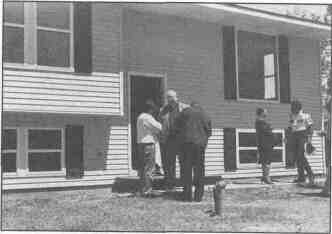Innovations First in-prison chapter of Habitat for Humanity at Kankakee could become model for nation With all the "get tough on crime/throw away the key" rhetoric flying around these days, it's somewhat reassuring to learn about efforts of people who remember that most of the 35,000 prisoners in our "corrections" system will be returning to lives on the outside. One small step toward giving some of those inmates a means to live productively among us is happening through Dwight Correctional Center, the state's female prison in Livingston County. In what may become a model for the nation, the first in-prison Habitat for Humanity chapter was formed through the cooperation of the Illinois Department of Corrections, Habitat for Humanity Inc. and Lutheran Social Services of Illinois. Habitat for Humanity Inc. is an ecumenical housing ministry that builds and rehabilitates houses with donated materials and volunteer labor, much of which comes from the "sweat equity" of the people buying the home. (Houses are sold at no profit to partner families, and no-interest mortgages are issued over a fixed period.) About a year ago a handful of women from the Kankakee Minimum Security Unit, a 100-bed satellite of Dwight Correctional Center for inmates close to release, began rehabilitating a house in Pembroke Township near Kankakee. Over the next nine months, eight women with no construction trades experience learned how to do wiring, tear out walls and build new ones, hang drywall, fix plumbing, install windows, paint and install new floors. New owners moved into the house in the spring.
Inmates from the Kankakee Minimum Security Unit helped to rehabilitate this home in Pembroke Township near Kankakee. The creative force behind this new approach to an age-old, and growing, problem is the Rev. Jack Nordgaard, state director of Lutheran Social Services' prisoner and family ministry. Nordgaard suggested the idea to Millard Fuller, founder of Habitat for Humanity and friend of former President Jimmy Carter, probably the most famous Habitat activist. Nordgaard says Fuller was immediately drawn to the concept and has written about the Dwight experience in a book about the Habitat movement. Nordgaard also gives credit to Howard Peters III, director of the state Department of Corrections, for being "open to new ideas." That openness to new ideas is evident in another "first" at Dwight Correctional Center. In September more than 20 percent of the inmate population volunteered to participate in a 5k walk for hunger held within the correctional facility walls. Sponsored by Church World Service/CROP, Church Women United of Illinois and the Illinois Department of Corrections, the 5k walk was held within the walls of the minimum security women's prison. Philip R. Johnson, chaplain at Dwight, says that 175 inmates and 40 people from the community walked for pledges totaling nearly $7,000. Twenty-five percent of the proceeds goes to local food banks, with the rest going to world hunger relief funds. Dorothy Yeoman of Church Women United says that women inmates and poor women around the world face similar challenges: hunger, unemployment, inadequate housing, health and welfare of their children, abuse, lack of health care and educational opportunities. Johnson agrees. He says no one is excusing the crimes the women have committed, but programs like the Habitat for Humanity chapter and the walk for hunger give them "opportunities to become self-reliant and to give something back to the community."
Illustration ©1993, Patrick Carr If coal rebounds in 20 years, education kits will be useful Illinois coal will make a comeback in the marketplace in the years 2010 to 2015, experts predict. Many of the people who will be making the political and economic decisions at that time are now in grade school. That's one of the reasons the Illinois Department of Energy and Natural Resources has developed education kits focusing on the state's abundant, but currently underused, natural resource. Fostering an understanding of coal, its uses, its problems and its importance to the state will produce support for coal products in the future, developers of the kit hope. Whether the subtle propaganda is taken to heart by these future leaders, the kit aimed at fifth and sixth graders is a well-designed lesson plan for teachers. Included are lessons on mining and safety, reclamation and subsidence, environment, clean coal technologies and coal's affect on the Illinois economy. Each lesson has an accompanying discussion work sheet. Several activities offer challenging hands-on experiments and class projects. Supplementary materials include a 10-minute video and a "genuine" chunk of Illinois coal. According to a spokesperson for ENR, the department has distributed 2,500 of the kits, and it is in the process of assembling another 2,500 kits. Angela Pentzien, a sixth grade teacher at Chatham Glenwood Junior High School in Sangamon County, says that she uses the kit to teach an energy unit with fellow teacher Michelle Kemp. They tie together science, social science and geography lessons with coal as the focus. With the success of the education kits directed at fifth and sixth graders, ENR is ready to distribute another coal education kit aimed at even younger students, those in kindergarten through second grade. Stay tuned. Poll results in 20 years. Beverley Scobell About this page Do you know of a governmental unit that is implementing an innovative program? Send your story to: Beverley Scobell, associate editor, Illinois Issues, Sangamon State University, Springfield, IL 62794-9243. Or e-mail your info to: scobell@eagle.sangamon.edu. 4/October 1994/Illinois Issues
|
|||||||||||||||


